2017 will mark the 10th anniversary of the iPhone and Apple has something major planned to celebrate the occasion. We’ve got several months to go until the launch of the iPhone 8, but because of Apple’s ambitious plans for the device, there are already an abundance of rumors hinting at the impressive features coming in the 2017 iPhone. There is no doubt that many people are concerned about the latest news of iPhone 8, for Apple is always the most popular brand. One of my firends is also longing for iPhone 8. However, he worries about the data lose which always happens when he uses phones. And he said he don’t want to see the same thing when he gets iPhone 8. Losing data on the iPhone is natural, for the Mac users, how to get back the deleted and lost data from iPhone 8 on Mac.
When this case happens, don’t worry, because iPhone Data Recovery for Mac can deliver you from this trouble safely and fast. This software is released to recover the lost or deleted data, such as contacts, messages, photos, videos, notes, WhatsApp messages, documents and so on, in a easy and reliable way. If you employ this software to data recovery, you will find that all the lost or deleted data you need is come back completely. In addition, iPhone Data Recovery supports most iOS system version and fulfills the task powerfully.
After launching iPhone Data Recovery for Mac on your Mac, select “Recover from iOS Device” option on the homepage of the software. Then, use the USB cable to connect your iPhone 8 to your Mac.
Tips: Please turn off the automatically sync in iTunes before running program or even don’t open iTunes along the recovery. Here is the steps to help you you disable the automatical syncing in iTunes beforehand: launch iTunes > Preferences > Devices, check “Prevent iPods, iPhones, and iPads from syncing automatically”.
Simply click the “Start Scan” button to allow iPhone Data Recovery to scan your iPhone 8 for deleted or lost data. The scanning g process may last a few minutes, depending on the amount of lost and existing data on your iPhone 8. During the scanning process, if you see that the data you’re looking for is scanned, then you can click the “Pause” button to stop the process.
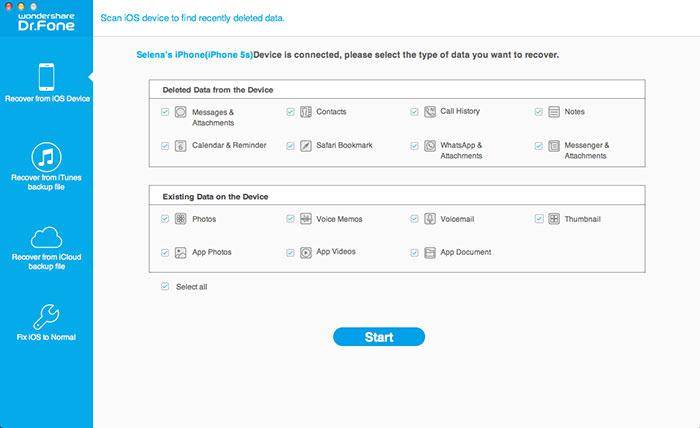
Once the scan is completed, you can see a scan result generated by the program. Both lost and existing on your device are found and displayed in categories. If you just want to see the found deleted data on your iPhone 8, you can swipe the option “Only display the deleted items” to ON.
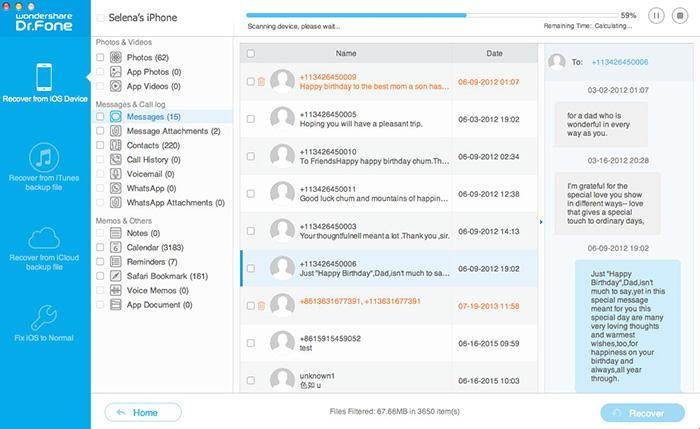
By clicking the file type in the left side, you can preview the found data. And you can see there is a search box on the top right of the window. You can search for a specific file by typing a keyword in the search box.
After you preview the data, select them to recover. Once you make sure the data you need is checked, please click the “Recover” button at the bottom right of the window. The selected data usually will be recovered and saved to your Mac.
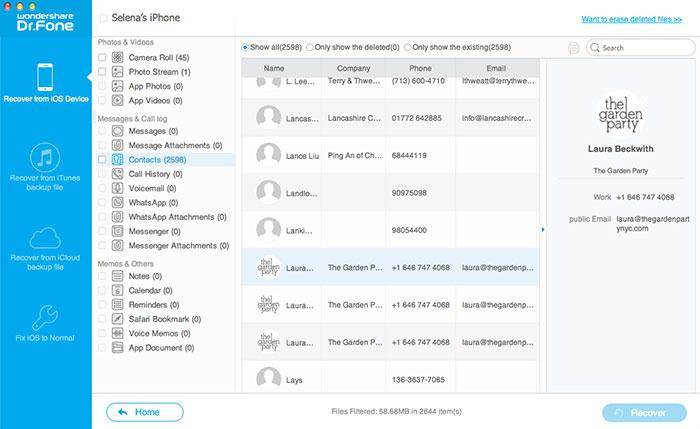
As for text messages, iMessage, contacts, or notes, when you click Recover, a pop-up will ask you to “Recover to Computer” or “Recover to Device”. If you want to put these messages back to your iPhone 8, click “Recover to Device”.
More Informations:
Changing the iPhone, restoring the device or synchronizing music may sometimes delete your contact details. If you encounter this situation, the easiest way is to restore through iCloud. If you have enabled iCloud contact synchronization (usually selected by default), you should be able to restore your contacts in a few simple steps:
1. Go to Settings on iCloud.com, and then click Restore Contacts (in the Advanced section). Available versions are listed by filing date and time.
2. On the right side of the version you want to restore, click Restore. There may be more versions than one that can be displayed at a time.
3. If you find that your contacts are not in your iCloud account, you can also examine your iTunes account carefully. By connecting the iPhone to the PC and restoring iTunes, you can download all the archived information stored on iTunes. However, please note that will delete all data on your phone and replace it with the content stored in your account.
With the release of iOS, Apple can more easily retrieve deleted photos and videos from the iPhone. You just need to follow these steps, but there’s an important caveat that I’ll explain later:
1. Go to the photo app for the iPhone and click on the album on the bottom toolbar.
2. Scroll down the list and then click on the latest deletion. As the name implies, you can find albums of recently deleted photos and videos here.
3. If you find the lost image, just click on a single photo, then choose to restore it to add back to the album, or if you want to delete it permanently, choose to delete it.
Warning: Recent deletions show only photos and videos from the past 30 days. After that, the file will be permanently deleted. If you’re looking for photos over 30 days, you can restore the iPhone from an old backup using iTunes.
Users of the iPhone can download third-party software, etc. But before using these third-party applications, you can try another way to retrieve deleted text messages from your iPhone.
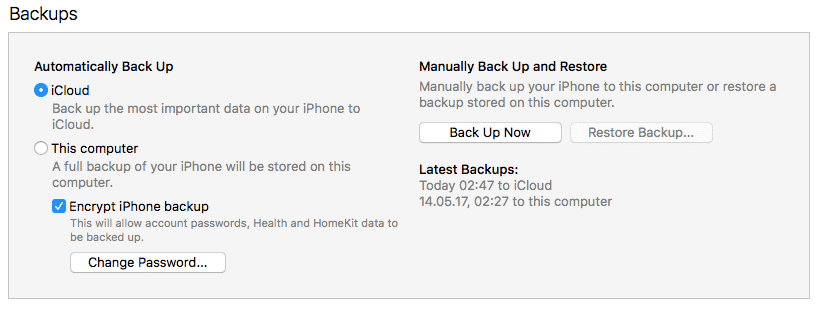
This method is invalid if you disable the synchronization option in iTunes. If you have enabled the synchronization option, you may recover lost text messages, because as long as your device is connected to the system, the synchronization function creates a backup on your PC.
There are three steps to retrieve lost messages in iTunes:
1. Connect the iPhone to PC/Mac (which you often use) and open iTunes.
2. Now select the “Restore Backup” option in iTunes (after selecting the device).
2. The “Restore Backup” option replaces the current data of the device with backup data. This may take a few minutes, and the message you lost will eventually be displayed on your device. However, backing up data is possible only after deleting messages.
Conclusion
It’s always better to use backup applications on smartphones. Retrieving lost messages is not easy and usually unsuccessful. Many times deleted messages cannot be restored.
Police and intelligence agencies can retrieve information because they have experts to help them. Authorities can also request help from mobile phone operators because they can also access users’messages. However, operators only provide help to the authorities, not to customers.
* Reset Your iPhone or iPad to Factory Settings
Factory reset restores the device to factory settings by resetting the entire system. All data and applications will be deleted because the drives in the device will be reformatted. To reset your iPhone’s settings (the iPad’s steps are basically the same) and clear all of the data, follow these steps:
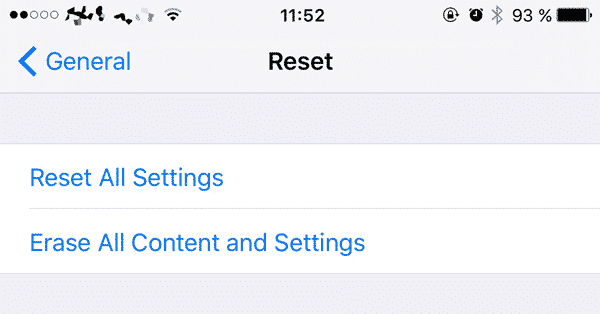
1. Go to Settings and scroll down until you find the Reset tab. You’ll see some options that you can reset, such as a keyboard dictionary or home screen layout.
2. To restore your iPhone to its factory default settings, click “Erase all content and settings” and then click “Erase iPhone.” If a password or a restricted password is set, you will be asked to enter a password before you can reset the device.
3. After entering your password, you will be asked to enter your Apple ID password. Enter it to start erasing all data in the device.
4. The reset back to factory settings will run and should not exceed a few minutes. When you see the welcome screen, it means that the factory reset is complete and there is no personal data on the device.
* Perform Reset with no Passcode using iTunes
There is a way to replace the above method, which can be done using iTunes. It’s good when you can’t open your iPhone because it’s disabled (too many wrong password attempts) or when you don’t remember the password. Proceed as follows:
1. Open iTunes. To prevent any potential obstacles during the reset process, make sure your iTunes version is up to date, just click “Check for updates” in the drop down menu.
2 Connect your iPhone to your computer. If you want to keep some files, you can click “Backup Now” to back up. If you only want to delete everything without saving it first, you can skip the backup.
3. Click the “Restore iPhone” option in iTunes and click “Agree” to confirm your decision. If you change your mind and decide to restore your data on your phone, click Restore from Backup….
* Reset Your iPhone or iPad using Find My iPhone
Alternatively, you can use “Find My iPhone.” If your iPhone is lost or stolen, and you want to make sure that no one can access its data, this is very convenient. To do this, perform the following steps:
1. Visit the “Find My iPhone” website and sign in with your Apple ID.
2. If there are multiple devices in this account, select the device you want to reset from the list of available devices.
3. Click the “Erase iPhone” (or iPad if you are resetting your tablet) option in the device info box. You will be asked to confirm your decision. After that, the reset will begin. If the device is offline, it will start as soon as the device comes online.
Keep in mind that if you set the Family Sharing setting, you can also reset your family member’s device to the factory default settings. When you reset your iOS device, you will be asked to enter your phone number and message, which will be displayed on the screen when the reset is complete.